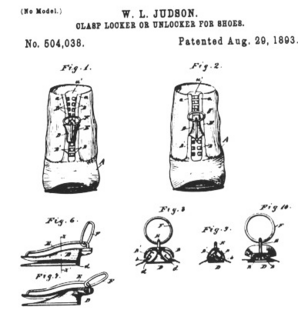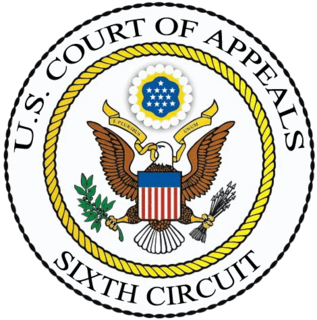Related Research Articles

Hans Lipperhey, also known as Johann Lippershey or Lippershey, was a German-Dutch spectacle-maker. He is commonly associated with the invention of the telescope, because he was the first one who tried to obtain a patent for it. It is, however, unclear if he was the first one to build a telescope.

Antonio Santi Giuseppe Meucci was an Italian inventor and an associate of Giuseppe Garibaldi, a major political figure in the history of Italy. Meucci is best known for developing a voice-communication apparatus that several sources credit as the first telephone.
Bauer & Cie. v. O'Donnell, 229 U.S. 1 (1913), was a 1913 United States Supreme Court decision involving whether a purchaser of a patented product bearing a price-fixing notice incurs guilt of patent infringement by reselling the product at a price lower than that which the notice commands. A divided Court (5–4) held that it was not.

Elisha Gray was an American electrical engineer who co-founded the Western Electric Manufacturing Company. Gray is best known for his development of a telephone prototype in 1876 in Highland Park, Illinois. Some recent authors have argued that Gray should be considered the true inventor of the telephone because Alexander Graham Bell allegedly stole the idea of the liquid transmitter from him. Although Gray had been using liquid transmitters in his telephone experiments for more than two years previously, Bell's telephone patent was upheld in numerous court decisions.
In United States patent law, utility is a patentability requirement. As provided by 35 U.S.C. § 101, an invention is "useful" if it provides some identifiable benefit and is capable of use and "useless" otherwise. The majority of inventions are usually not challenged as lacking utility, but the doctrine prevents the patenting of fantastic or hypothetical devices such as perpetual motion machines.

Laurens Hammond, was an American engineer and inventor. His inventions include the Hammond organ, the Hammond clock, and the world's first polyphonic musical synthesizer, the Novachord.

Whitcomb L. Judson was an American machine salesman, mechanical engineer and inventor. He received thirty patents over a sixteen-year career, fourteen of which were on pneumatic street railway innovations. Six of his patents had to do with a motor mechanism suspended beneath the rail-car that functioned with compressed air. He founded the Judson Pneumatic Street Railway.

The invention of the telephone was the culmination of work done by many individuals, and led to an array of lawsuits relating to the patent claims of several individuals and numerous companies.

Kálmán Tihanyi or in English language technical literature often mentioned as Coloman Tihanyi or Koloman Tihanyi was a Hungarian physicist, electrical engineer and inventor. One of the early pioneers of electronic television, he made significant contributions to the development of cathode ray tubes (CRTs), which were bought and further developed by the Radio Corporation of America, and German companies Loewe and Fernseh AG. He invented and designed the world's first automatic pilotless aircraft in Great Britain. He is also known for the invention of the first infrared video camera in 1929, and coined the first flat panel (plasma) display in 1936. His Radioskop patent became part of the UNESCO's Memory of the World Programme.

Hassan Kamel Al-Sabbah was a Lebanese
Gottschalk v. Benson, 409 U.S. 63 (1972), was a United States Supreme Court case in which the Court ruled that a process claim directed to a numerical algorithm, as such, was not patentable because "the patent would wholly pre-empt the mathematical formula and in practical effect would be a patent on the algorithm itself." That would be tantamount to allowing a patent on an abstract idea, contrary to precedent dating back to the middle of the 19th century. The ruling stated "Direct attempts to patent programs have been rejected [and] indirect attempts to obtain patents and avoid the rejection ... have confused the issue further and should not be permitted." The case was argued on October 16, 1972, and was decided November 20, 1972.

A dictation machine is a sound recording device most commonly used to record speech for playback or to be typed into print. It includes digital voice recorders and tape recorder.
Odo Josef Struger was an Austrian pioneer in modern-day automation.
Thomas David Petite is an American inventor. He is Native American and a member of the Fond du Lac Band of Lake Superior Chippewa tribe. He is also a founder of the Native American Intellectual Property Enterprise Council, a non-profit organization helping Native American inventors and communities.

A timeline of United States inventions (1890–1945) encompasses the ingenuity and innovative advancements of the United States within a historical context, dating from the Progressive Era to the end of World War II, which have been achieved by inventors who are either native-born or naturalized citizens of the United States. Copyright protection secures a person's right to his or her first-to-invent claim of the original invention in question, highlighted in Article I, Section 8, Clause 8 of the United States Constitution which gives the following enumerated power to the United States Congress:
To promote the Progress of Science and useful Arts, by securing for limited Times to Authors and Inventors the exclusive Right to their respective Writings and Discoveries.

Abraham Lincoln's patent relates to an invention to buoy and lift boats over shoals and obstructions in a river. Abraham Lincoln conceived the invention when on two occasions the boat on which he traveled got hung up on obstructions. Lincoln's device was composed of large bellows attached to the sides of a boat that were expandable due to air chambers. Filed on March 10, 1849, Lincoln's patent was issued as Patent No. 6,469 later that year, on May 22. His successful patent application led to his drafting and delivering two lectures on the subject of patents while he was president.
John Tregoning was an American mechanical engineer, inventor and business manager from Lynn, Massachusetts, known for writing one of the first books on factory operations in 1891. and as early systematizer of management.
Joel Solon Spira was an American inventor, entrepreneur, and business magnate.
Henry v. A.B. Dick Co., 224 U.S. 1 (1912), was a 1912 decision of the United States Supreme Court that upheld patent licensing restrictions such as tie-ins on the basis of the so-called inherency doctrine—the theory that it was the inherent right of a patent owner, because he could lawfully refuse to license his patent at all, to exercise the "lesser" right to license it on any terms and conditions he chose. In 1917, the Supreme Court overruled the A.B. Dick case in Motion Picture Patents Co. v. Universal Film Mfg. Co.,

The Button-Fastener Case, Heaton-Peninsular Button-Fastener Co. v. Eureka Specialty Co., also known as the Peninsular Button-Fastener Case, was for a time a highly influential decision of the United States Court of Appeals for the Sixth Circuit. Many courts of appeals, and the United States Supreme Court in the A.B. Dick case adopted its "inherency doctrine"—"the argument that, since the patentee may withhold his patent altogether from public use, he must logically and necessarily be permitted to impose any conditions which he chooses upon any use which he may allow of it." In 1917, however, the Supreme Court expressly overruled the Button-Fastener Case and the A.B. Dick case, in the Motion Picture Patents case.
References
- ↑ von Ruff, Al. "Bibliography: Stability". ISFDB . Retrieved 2012-10-17.[ self-published source ]